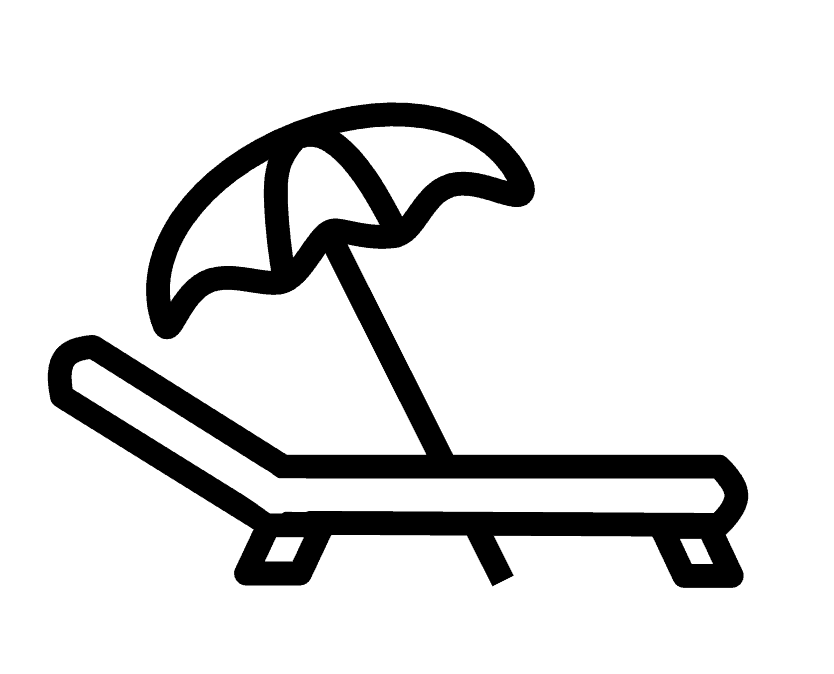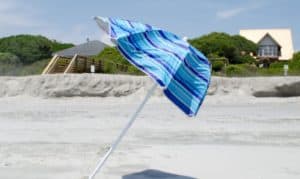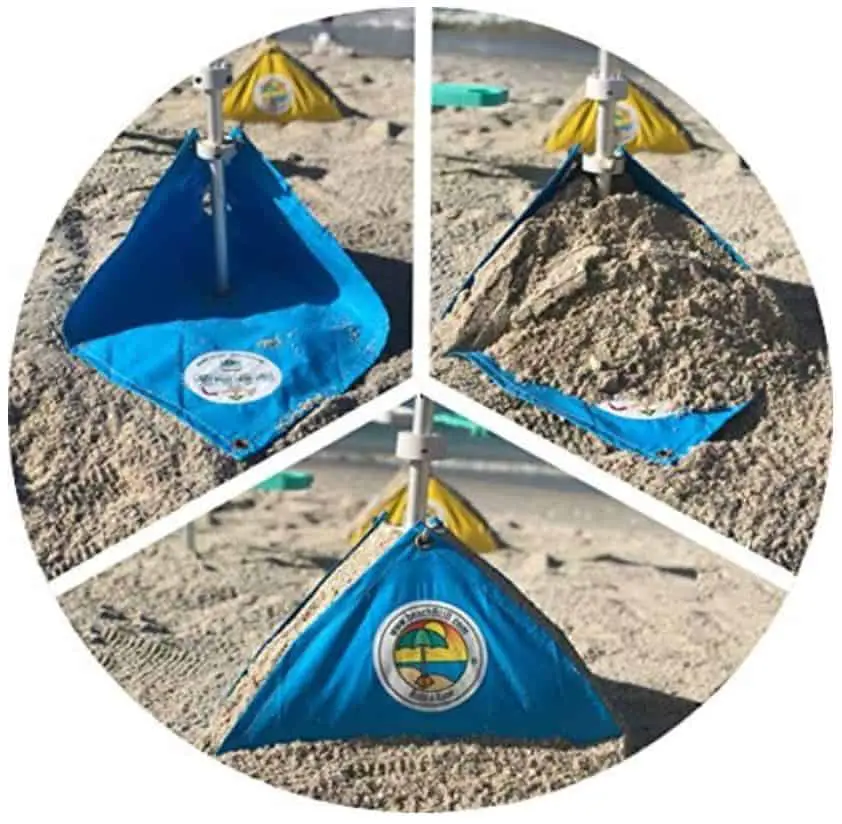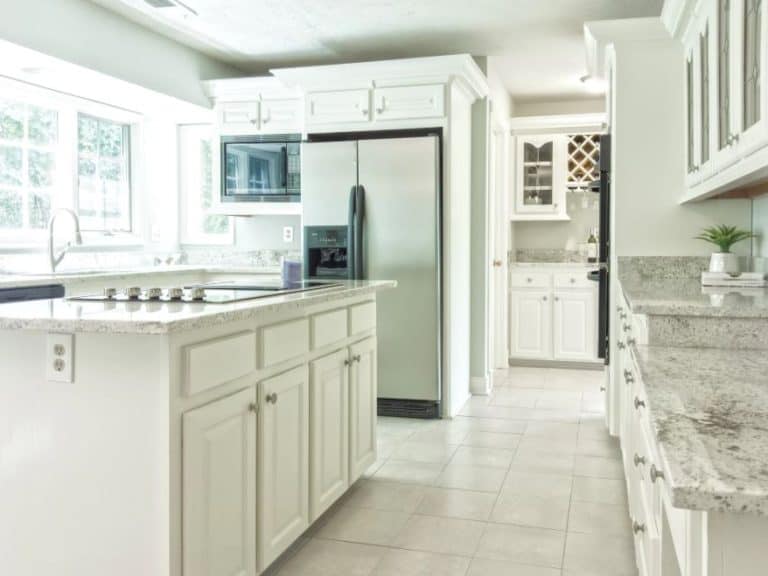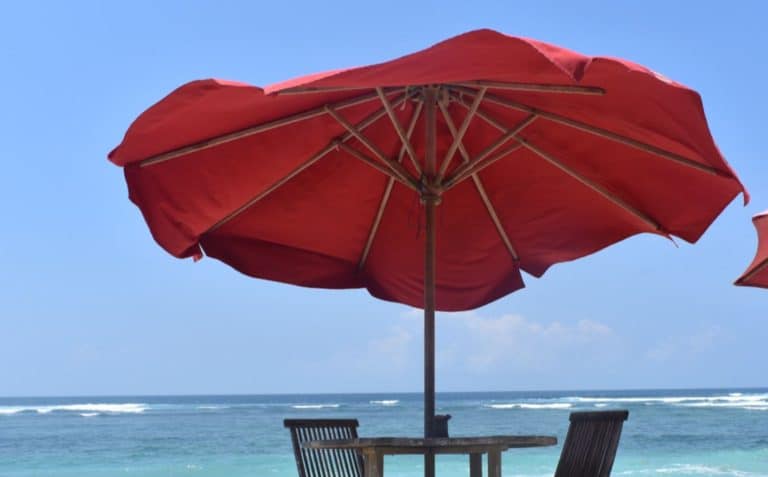Your Beach Umbrella blowing away can be a disaster for your day at the beach but even worse it can become a dangerous weapon with lots of sharp pointy bits. Data from the US Consumer Product Safety Commission (CPSC) indicates that more than 2,800 people were treated in hospitals for umbrella-related injuries between 2010 and 2018. At some beaches securing methods are now law!
With paying guests we are always extra careful to avoid any accidents, so before supplying guests with Umbrellas I did some research. Wanting to stop them from blowing away is a given and explained below but as I discovered there are also a number of alternative securing methods, and also some key points to remember!
Jump Straight to :
- The Ultimate Solution to Stop Beach Umbrellas Blowing Away
- How to Properly Install a Beach Umbrella in the sand.
- Why Beach Umbrellas and Patio Umbrellas are NOT the Same!
- What to look for in a good beach umbrella?
- Beach Umbrella Anchors
- How Fast is the Wind? – How to Identify the Wind Speed in Different Conditions
- Suggested Anchoring Products
- Don’t use an Umbrella at all!
The Ultimate Solution to Stop Beach Umbrellas Blowing Away
The best solutions allow for personal preference and need to be adjusted to suit the location. With lots of different beach types and physical abilities, my conclusion is that the Ultimate Solution is a combination of a properly installed umbrella (positioning, angle, depth, etc) and either a screw or sandbag anchor, depending on preference. Individually none of the solutions can cover all scenarios.
Further information about each is given below.
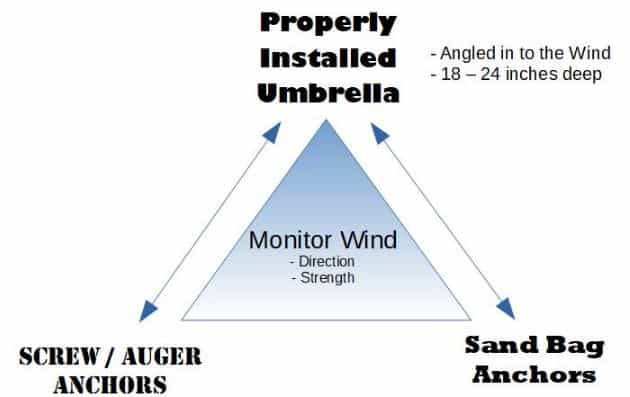
How to Properly Install a Beach Umbrella in the sand.
Time needed: 3 minutes
How to Install a Beach Umbrella – Step-by-step
- Choose a Suitable Spot
Take note of the wind direction. Observing nearby flags or simply letting some loose sand trickle out of your hand will show you the local wind direction.
Avoid areas where the wind will funnel. The low point between two sand dunes, the gap between two buildings or the end of a long built-up street can all act as funnels for wind, making it stronger than in other spots.
Note: Flags on high buildings can be misleading as the wind direction usually changes at different heights. - Clear Loose Sand
The top few inches of sand will normally be very ‘loose’. Move the loose sand to the side for an area of about 1ft square. This ensures that you will get the best holding, firmer sand.

- Plunge the bottom of your Umbrella pole.
Being careful not to stab your own feet (!), plunge the pointed end of the umbrella into the center of your prepared area. You want this as deep as possible but any depth is OK, it is just for starting the hole.
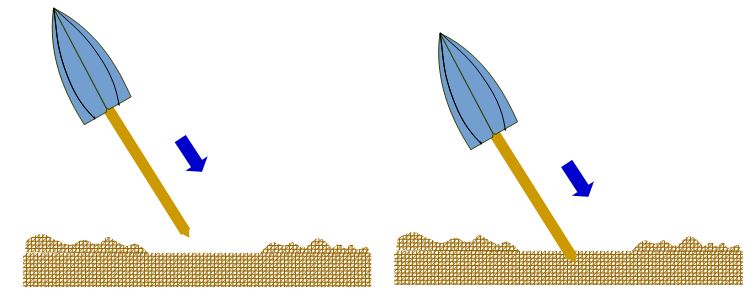
- Rock the whole Umbrella
Whilst pushing down, you then rock the whole umbrella back and forth by about 45 degrees. This will slowly inch the bottom of the pole deeper into the sand.
For a typical 7ft canopy you should be aiming for the pole to be about 18 – 24 inches deep from your cleared area.
Tip: Ideally the rocking motion is only back and forth, not in a circular motion to avoid making all the sand loose.
Note: In areas of particularly loose, dry sand, as often found on sand dunes, you may want the pole to be even deeper.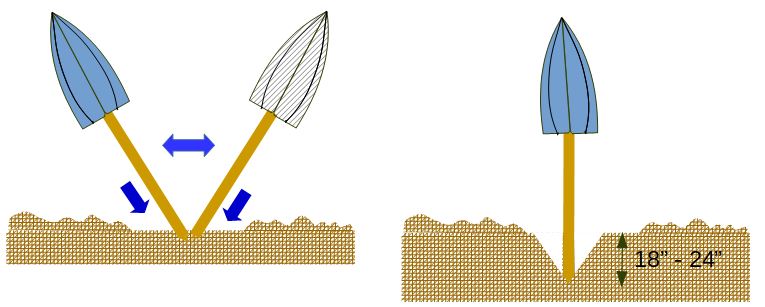
- Opening the Canopy
Firm Holding: If it’s possible to remove the umbrella without the hole collapsing.
Remove the umbrella from the hole, turn it upside down and secure open the canopy. Then carefully turn it back over and insert back into the hole.
Soft Holding: The hole simply collapses and fills with sand when the pole is removed.
It may be necessary to open the canopy before ‘Step 4’ or to have someone lie on the ground holding the pole while you open the canopy.
Note: The beach umbrella canopy tends to be lower to the ground than a patio umbrella so the opening can be more challenging. - Final Postioning
With the umbrella back in the hole, canopy up, you then want to angle the top of the canopy towards the wind. This should be done with a straight pole, not the tilting style. (See explanation below)
Angling the canopy into the wind by at least 15 degrees will make a huge difference. It uses the wind to help push the umbrella into the sand, rather than just creating a sail to be blown away!
Note: The greater the angle into the breeze the more secure but it will also impact how much shade the umbrella can offer.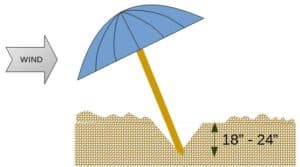
- Securing the Umbrella
When you are happy with the angle you then need to back fill the hole around the pole. Ideally you want to compress the sand as much as possible, by firmly stepping around the pole. You should then pile the sand up around the pole to give it a little more support.
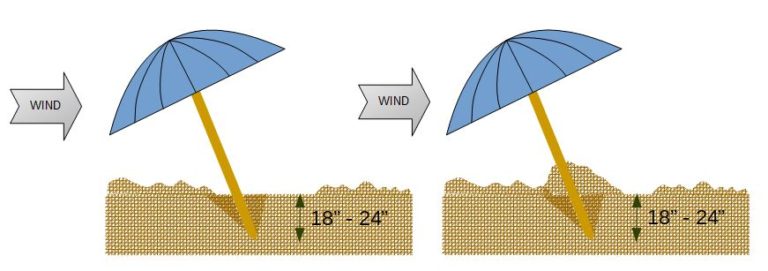
- Watch for changes in the Wind
A well installed beach umbrella can withstand relatively strong winds, often far stronger winds than is pleasant for being at the beach. However, the direction and strength of the wind is rarely constant.
If the wind changes direction then you need to be aware and to alter the direction in which the canopy is facing. - Avoid Gusty wind Conditions.
Gusty wind is more problematic. These short bursts of much stronger wind, frequently 15+ mph stronger, are the main problem for umbrellas. Although only short-lived the additional wind speed usually along with a change in direction makes these conditions unsuitable for using a beach umbrella.
Why Angle a Beach Umbrella into the Wind?
Ordinarily, with a patio umbrella, you want to present the smallest amount of area to the wind to reduce the amount of wind force that will act upon it.
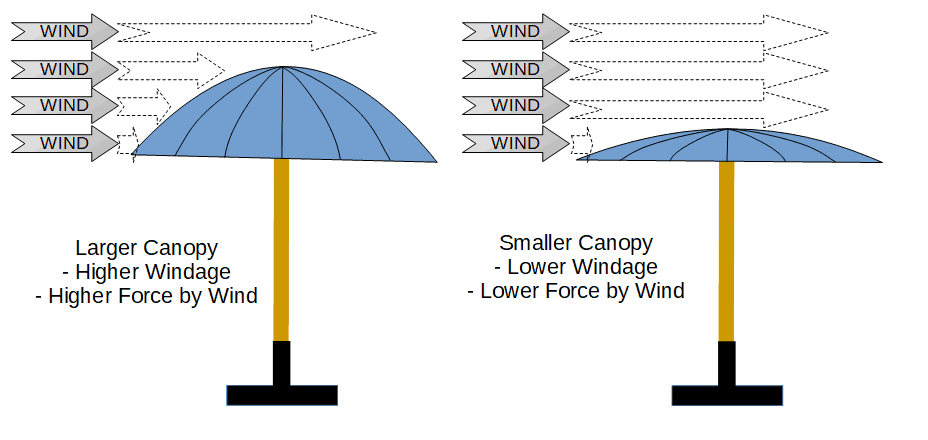
It is common sense that by reducing the amount of canopy, you will reduce the windage, your umbrella will experience less wind force and therefore be less likely to take off.
For a properly installed beach umbrella, it becomes a little more complicated. When installed leaning into the wind, you are intentionally presenting a much greater area for the wind to push against.
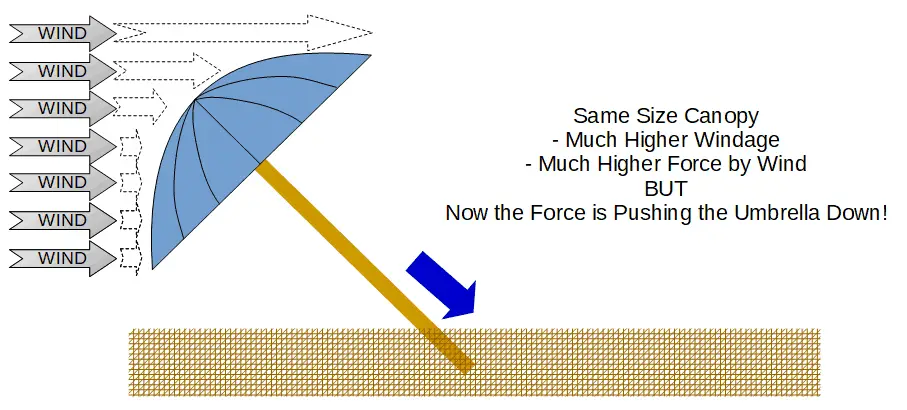
If you have your umbrella angled into the wind (with the top of the canopy facing the wind) then the force of the wind may actually help push the umbrella down.
Note: This is NOT the same as tilting the canopy of your umbrella!
Why Just Tilting the Canopy of your Beach Umbrella isn’t Ideal
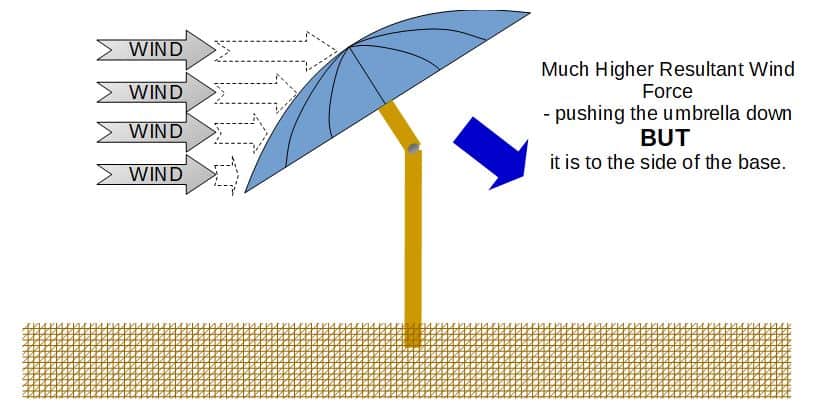
When you tilt the top of your Umbrella towards the wind, the wind force will indeed help to push it down, instead of just horizontally. However, it is still pushing it down to the outside of the base, so it is still inclined to topple. When you then also consider all the extra windage, meaning the wind force is now much greater, it is not a good idea to tilt just the canopy of your Beach umbrella when it is windy.
Why Beach Umbrellas and Patio Umbrellas are NOT the Same!
| Beach Umbrella | Patio Umbrella |
| Designed to be carried around; therefore are relatively light. | Intended to be left in place; tend to be heavier |
| Pole diameter tends to be thinner and shorter (weight saving) | Pole diameter tends to be thicker and longer |
| Intended to be ‘planted’ into the ground | Require a ‘Base’ to stand up in |
| Pointed on the bottom of the pole | Flat bottom |
What to look for in a good beach umbrella?
Sun Protection
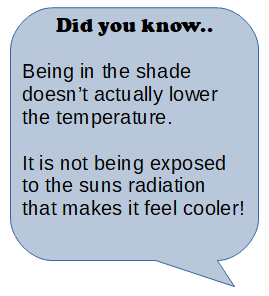
The whole point in having an umbrella at all is for direct protection from the sun’s rays/radiation.
Being in the shade on a hot day can feel as though it is as much as 15 degrees cooler than standing in direct sunlight.
It is the UV protection that helps reduce the effect of the direct sun rays on your eyes and skin. A good beach umbrella will have a SPF (Sun Protection Factor) of at least 40 but ideally 50+. This can be achieved by a whole variety of materials, like Shade Sails, canvas style or those with silver UV coating (not recommended; see Note below).
With the high SPF a given, in most cases, it is the material’s other characteristics that will determine which is suited to your use. The weight, durability, flexibility, cost etc
IMPORTANT NOTE: Shade works by physically shielding skin from direct harmful UV rays; however, skin may still remain exposed to reflected (off the sand, water, silver underside of umbrella etc) and indirect UV rays. Neither shade from a beach umbrella, nor sunscreen, alone can provide sufficient protection for extended exposure to UV rays. A combination of the two is needed for optimal protection from UV rays .(Clinical Study)
Strong pole
The strength of the pole is not just for withstanding greater winds, rather it is to allow you greater leverage when installing the pole into the sand.
In most cases, consumer umbrellas will have an aluminum pole suited for the size of the canopy. Ideally, you want one with a thicker diameter but also a thicker wall thickness of the pole.
Most commercial beach umbrellas, particularly those used by rental companies tend to use 2″ diameter solid wood poles, as it gives them the strength as well as durability.
N.B: This is still relevant if you utilize one of the screw style sand anchors into which you then position your umbrella. The thinner poles can bend and break; the screw anchor doesn’t move but where it grips the pole with a thumb screw creates a weak point.
Vents
In many cases, it is the umbrella lifting up, and then becoming unstable, which actually causes it to topple over. Added vents can make a big difference to how umbrellas cope with gusty conditions, for two reasons:
- Wind does not blow uniformly and as it gets stronger it can have a greater vertical component that can push the umbrella up or down.
- If the umbrella gets caught in an up-current then the vents act as holes, simply allowing some of the airflow to escape straight through the canopy.
- The umbrella shape is very similar to that of an airplane wing and as such when the wind blows it causes the wind to change direction which creates lift! (NASA – Lift from flow) Adding vents helps to reduce this lift as it reduces the air pressure difference above and below the canopy.
The more vents, the more the lift is reduced and the more airflow that can escape.
The additional benefit of the vents is that, on a still day, any build-up of hot air underneath the canopy will not get trapped as it can rise up through the vents.
Beach Umbrella Anchors
A number of US beaches now have or are considering legislation requiring umbrellas to be secured or else face fines as high as $250!
When considering which style and brand of sand anchor it is recommended by the American Lifeguard Association that it is rated for at least a 35mph wind.
In most cases, it is pleasant to be at the beach in winds up to around 12-15 mph, and its OK up to about 18-20 mph. After that sand can start to be blown around and given that gusts can easily be 15+mph stronger it would be unsuitable for using an umbrella. See Wind Speed Guide below.
Screw Anchor a.k.a Auger Anchor.
These are probably the most common and obvious to use. They consist of a short length of threaded pole with handles. They are simply screwed into the sand to a suggested depth (~15 inches) and then the umbrella pole is inserted inside the screw anchor. The pole is then secured to the screw anchor by means of a ‘thumbscrew’ / bolt that is tightened, much like a patio umbrella base.
Note: Check for compatibility with your umbrella pole. Some Anchors do not fit the larger (2″) diameter poles.
| Screw Material | Pros | Cons |
|---|---|---|
| ABS Plastic | Lightweight No Corrosion Strong Enough for normal sand | May develop small ‘nicks’ in the screw edge that can be sharp |
| Metal | Very strong and rugged | More susceptible to corrosion, Heavier to carry |
Comments:
- Simple to install but getting them deep enough can be hard work on some beaches
- Relatively fast in deep soft sand
- Not so easy to install at an angle; as you get deeper, at an angle, the handles can hit the sand.
Sandbag Anchors
As the name suggests these use the plentiful supply of sand at the beach to create weighted bags that are then attached to the umbrella. Some are designed to attach to the pole whilst other use straps/lines to fix to the struts of the canopy or the hub where they struts meet the pole.
Note: These do not replace the need to ‘plant’ the umbrella pole in the sand but do make it easier as you don’t have to achieve the recommended18 – 24″. In most cases a depth of only ~8″ is suggested as necessary.
The quality of the different products on offer seems to vary significantly from the highly regarded but expensive BeachBub to the more basic, cheaper nylon bags with tent lines.
Comments:
- Lightweight bags; can also be useful for getting things to and from the beach
- Super easy set-up; simply filling a bag with sand
- Can be used with any umbrella diameter
- Suitable for any beach; even those where it is difficult to screw in an anchor
- Filling the bag might take a little longer
- Some secure via attachment to the canopy struts; this is not part of the canopy’s intended design.
How Fast is the Wind? – How to Identify the Wind Speed in Different Conditions
| 0 — Calm | less than 1 mph (0 m/s) | Smoke rises vertically |
| 1 — Light air | 1 – 3 mph 0.5-1.5 m/s | Smoke drifts with air, weather vanes inactive |
| 2 — Light breeze | 4 – 7 mph 2-3 m/s | Weather vanes active, wind felt on face, leaves rustle |
| 3 — Gentle breeze | 8 – 12 mph 3.5-5 m/s | Leaves & small twigs move, light flags extend |
| 4 — Moderate breeze | 13 – 18 mph 5.5-8 m/s | Small branches sway, dust & loose paper blows about |
| 5 — Fresh breeze | 19 – 24 mph 8.5-10.5 m/s | Small trees sway, waves break on inland waters |
| 6 — Strong breeze | 25 – 31 mph 11-13.5 m/s | Large branches sway, umbrellas difficult to use |
| 7 — Moderate gale | 32 – 38 mph 14-16.5 m/s | Whole trees sway, difficult to walk against wind |
Suggested Anchoring Products
Top Choice – Auger Style
AugHog Beach Umbrella Anchor; Commercial Grade
- Longer than most other auger styles; more support
- Combines the benefits of both metal and plastic
- Stainless steel fittings; No Corrosion
- Removable handle
- Pole diameter up to 1.6″
- UV and IMPACT resistant
Top Choice – Sandbag Style
BeachBub Beach Umbrella System
- Stainless Steel Fittings; no corrosion
- Doesn’t require deep screwing into the beach (~8-10 inches)
- Can be easily adjusted with moving wind
- Adds ~120lbs of weight
- Endorsed by the American Life Guard Association
This product can be bought including an endorsed 7.5ft canopy umbrella or just the ‘base’ for use with any pole size.
Basic – Screw Anchor
Beachr Beach Umbrella Sand Anchor
- Lightweight, portable and compact
- ABS Plastic
- Reinforced Handles
- Fits poles up to 2″
Alternative Solution
- Has a high SPF 50+
- Water repellent
- Side pockets can be filled with sand for additional securing weight
- Suitable for gusty condition WHEN installed INTO the wind.
Don’t use an Umbrella at all!
Take a tent. Even the most basic models are usually designed to deflect the wind and they have the extra guys etc to help make it secure. You can also use it for getting changed in privacy or for hiding things out of sight.
For more information regarding How to Stop Patio Umbrellas from Blowing Away then check out our other post.
